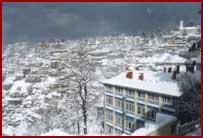
 |
| Visa: Documentation::: Emigration :: Legalization :: News :: Distance Chart : Holidays Home :: Profile :: Contact :: Email |
|
|
|
SHIMLA
The
Capital of The Mountain State of Himachal Pradesh
Places to visit in Himachal :
Chamba
,
Daramshala, Kangra,
Kullu,
Manali
,Mandi
,
Shimla
Places to
visit in Shimla :
Jakhoo
Hill,
Shimla
State Museum,
Summer
Hill,
Shimla
Mall
Introduction : Click
Here For Map Of Himachal
 History
of Shimla started from Stately Windsor Castle where the "Widow
of Windsor" reigned in lonely, isolated splendour after the death of
her beloved consort, Prince Albert, to the small, but ancient temple
surrounded by thick woods where the himalayan Goddess, Shamla, a synonym
of Kali, reigned her celestial realm on earth is indeed, distant cry, but
for well over a century, the two places, almost inter-linked, ruled the
destiny of this sub-continent. In the year 1818, when Queen Victoria's
uncle, William IV, was King of England, Lord William Bentick, the Governer
General, had transformed the Company's dominion in India to the Dominion
of India, and it was accurate to speak of Britain's Indian Empire. The
frontier ran from bengal to Kathiawar, to the north it ran through the
Thar desert and along the Sutlej nearly to the Himalayan range. The great
hills were the northern boundary except for the Gurkha state of Nepal.
Beyond this line lay the Punjab, Kashmir and the kingdom of Afghanistan.
In 1814, the Nepalese king brought about the first war with Nepal over
Sikkim, the Gurkhas had marched into Sikkim, whose ruler appealed, to the
East India Company for help. The Sikkim ruler was installed and his
territorial status was guaranteed but during the conflict the British
discovered the beauties of Darjeeling and accidentally also the thickly
wooded spot, abode of the goddess Shamla, and a part of the Kingdom of
Nepal. When war broke afresh in 1819, the British took the place with its
cool and healthy climate. Shimla is capital of Himachal Pradesh.
History
of Shimla started from Stately Windsor Castle where the "Widow
of Windsor" reigned in lonely, isolated splendour after the death of
her beloved consort, Prince Albert, to the small, but ancient temple
surrounded by thick woods where the himalayan Goddess, Shamla, a synonym
of Kali, reigned her celestial realm on earth is indeed, distant cry, but
for well over a century, the two places, almost inter-linked, ruled the
destiny of this sub-continent. In the year 1818, when Queen Victoria's
uncle, William IV, was King of England, Lord William Bentick, the Governer
General, had transformed the Company's dominion in India to the Dominion
of India, and it was accurate to speak of Britain's Indian Empire. The
frontier ran from bengal to Kathiawar, to the north it ran through the
Thar desert and along the Sutlej nearly to the Himalayan range. The great
hills were the northern boundary except for the Gurkha state of Nepal.
Beyond this line lay the Punjab, Kashmir and the kingdom of Afghanistan.
In 1814, the Nepalese king brought about the first war with Nepal over
Sikkim, the Gurkhas had marched into Sikkim, whose ruler appealed, to the
East India Company for help. The Sikkim ruler was installed and his
territorial status was guaranteed but during the conflict the British
discovered the beauties of Darjeeling and accidentally also the thickly
wooded spot, abode of the goddess Shamla, and a part of the Kingdom of
Nepal. When war broke afresh in 1819, the British took the place with its
cool and healthy climate. Shimla is capital of Himachal Pradesh.
| Jakhoo Hills |
|
For lovers of solitude, a short climb, early in the morning to the summit of Jakhoo at a height of 2,438.4 metres and two kilometers (1 1/4) east of the town, towering over Shimla, ewards the climber with the glorious spectacle of the sun rising over the eternal snows and a panoramic view of Shimla spreadeagled below. Here, too, is an old temple dedicated to the god Hanuman, now also the home of countless playful monkeys waiting hopefully to be fed by all the visitors. |
| Shimla State Museum |
|
|
Annadale (Shimla's Playground)
Developed as the playground of the capital, Annadale is as far down as Jakhoo is up. At an altitude of 1,864 metres is 2.4 Km from GAIETY THEATRE, in the old days it was used for picnics, circket and the Gymknana races, besides riding to the hounds. It is still a favourite spot for cricket, picnics and the princely game of Polo.
| Summer Hill |
|
Situated at a distance of 5 km from GAIETY THEATRE is the lovely suburb of Summer Hill, at an altitude of 1,982 M and on the Shimla - Kalka railway line. In these quiet surroundings with secluded shady walks, lived Mahatma Gandhi during his visits to Shimla. The Mahatma lived in the elegant Georgian house of Raj Kumari Amrit Kaur, daughter of the last ruler of the Punjab, Maharaja Dalip Singh, and free India's first woman minister. She held the Health Portfolio. |
|
Shimla Mall |
|
|
Copyright � 2002, Royaleeindiavisa.com Site Developed by EON Solutions